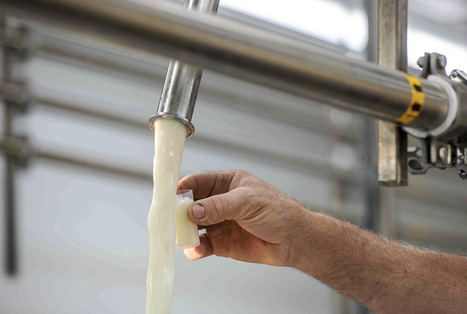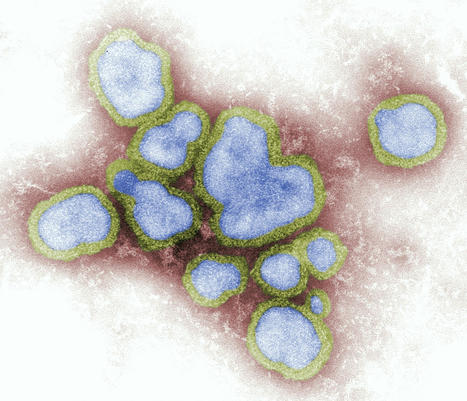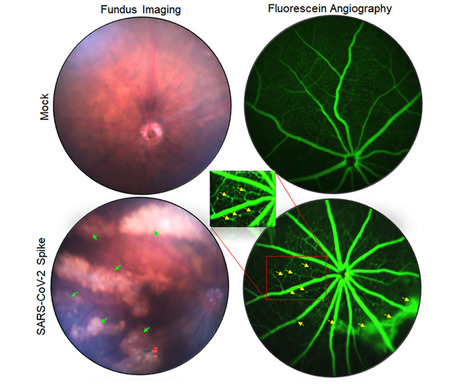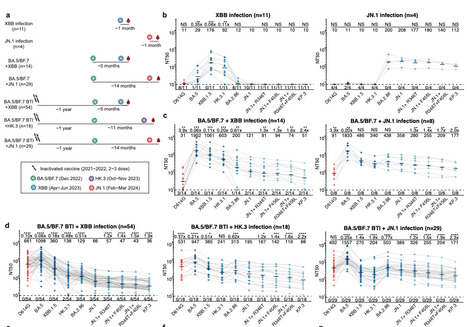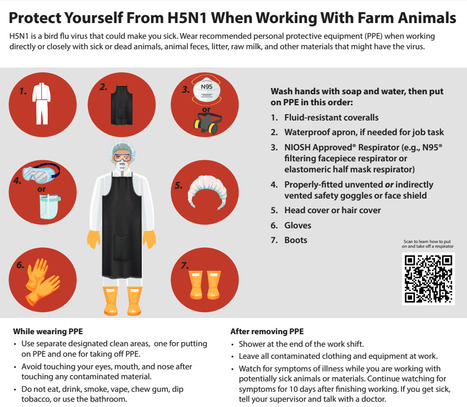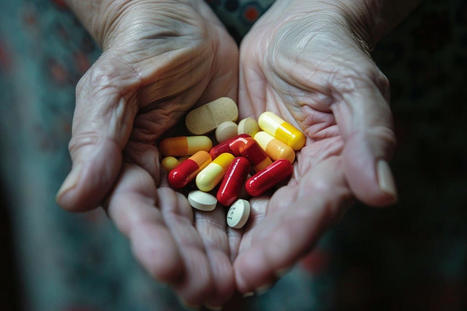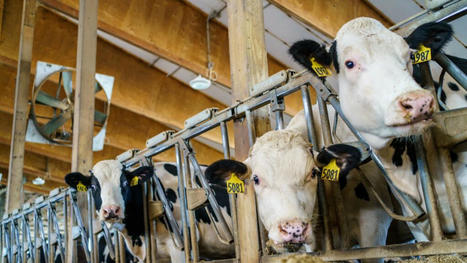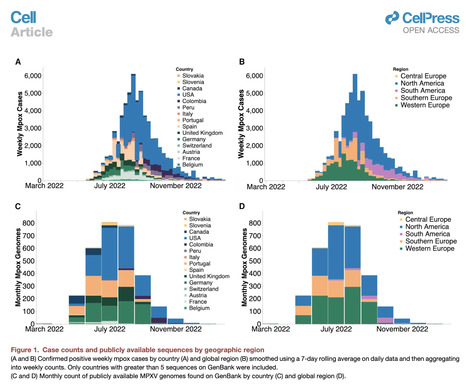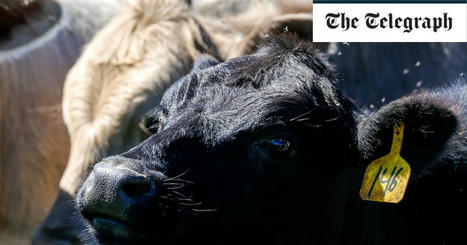 Your new post is loading...

|
Scooped by
Juan Lama
|
RetroVirox offers a menu of cell-based antiviral services to evaluate experimental therapies and vaccines against coronaviruses, including SARS-CoV-2. The company offers in vitro testing with SARS-CoV-2 pseudovirions and with live SARS-CoV-2 viruses to evaluate entry inhibitors, neutralizing antibodies, and antivirals against the novel coronavirus causative agent of COVID-19. Multiple viral strains are available for testing, including the most recent Omicron variants of concern (XBB.1.5, XBB.1.16, XBB.2.3.2, EG.5.1 and JN.1). Pseudoviruses coated with the viral spike (S) protein of SARS-CoV-2 are also used to recapitulate the mode of entry of the novel coronavirus. Over 50 spike mutant and variants are available as pseudoviruses. These assays can be used for the following purposes: - To determine the neutralizing activity of therapeutic antibodies and antisera
- To test experimental COVID-19 vaccines using antisera from inoculated animals or humans
- To evaluate small-molecule and other entry inhibitors targeting the S viral protein, the ACE-2 viral receptor, or host proteases and other targets involved in SARS-CoV-2 viral entry
Assays with live replicating SARS-CoV-2, and milder forms of seasonal human coronaviruses (hCoV-OC43 and 229E) allow for the evaluation of inhibitors at all stages of the coronavirus life cycle. Additional Information about the coronavirus assays and many other cell-based antiviral assays offered at RetroVirox is available here. Request additional information by email at info@retrovirox.com

|
Scooped by
Juan Lama
|
The ongoing evolution of SARS-CoV-2 to evade vaccines and therapeutics underlines the need for innovative therapies with high genetic barriers to resistance. Therefore, there is pronounced interest in identifying new pharmacological targets in the SARS-CoV-2 viral life cycle. The small molecule PAV-104, identified through a cell-free protein synthesis and assembly screen, was recently shown to target host protein assembly machinery in a manner specific to viral assembly. In this study, we investigate the capacity of PAV-104 to inhibit SARS-CoV-2 replication in human airway epithelial cells (AECs). We show that PAV-104 inhibits >99% of infection with diverse SARS-CoV-2 variants in immortalized AECs, and in primary human AECs cultured at the air-liquid interface (ALI) to represent the lung microenvironment in vivo. Our data demonstrate that PAV-104 inhibits SARS-CoV-2 production without affecting viral entry, mRNA transcription, or protein synthesis. PAV-104 interacts with SARS-CoV-2 nucleocapsid (N) and interferes with its oligomerization, blocking particle assembly. Transcriptomic analysis reveals that PAV-104 reverses SARS-CoV-2 induction of the type-I interferon response and the maturation of nucleoprotein signaling pathway known to support coronavirus replication. Our findings suggest that PAV-104 is a promising therapeutic candidate for COVID-19 with a mechanism of action that is distinct from existing clinical management approaches. PAV-104, a small molecule, potently inhibits SARS-CoV-2 replication in human airway epithelial cells by disrupting viral particle assembly and release. These findings suggest that PAV-104 holds significant promise as a therapeutic for COVID-19. Published (April 22, 2024): https://doi.org/10.1038/s42003-024-06130-8

|
Scooped by
Juan Lama
|
Drug hunters are finding that ancient virus-like artifacts in the human genome could offer new avenues to treat neurodegeneration, cancer, autoimmunity and even aging with antibodies, vaccines and antiretroviral agents. A new wave of therapies is taking aim at virus-like elements spread throughout the human genome. These genomic parasites, which have accumulated over the course of human evolution, are embedded in the vast expanse of DNA sequences that dwell in the spaces between our genes — what scientists call the ‘dark genome’. Although they were largely ignored in the past, growing scientific evidence indicates that these normally dormant elements — including retroviruses, transposons and other repetitive sequences — can reactivate, triggering inflammation, cancer and other disease-related cellular damage. Several companies have recognized this reactivation as an untapped clinical opportunity and are developing therapeutics to stifle these ancient interlopers. For example, Transposon Therapeutics’ lead drug candidate, TPN-01, was originally devised as an antiretroviral drug to block proliferation of HIV-1, but also appears to be a potent inhibitor of a dark genome-dwelling transposon known as LINE-1 (long interspersed nuclear element-1). This February, Transposon Therapeutics announced promising results from a phase 2 trial testing TPN-01 as a treatment for the neurodegenerative disorder progressive supranuclear palsy (PSP). Venture investors and pharma are paying attention. In September 2023, dark genome startup Rome Therapeutics reported $77 million in series B funding from major players including Sanofi, Bristol Myers Squibb and Johnson & Johnson — bringing their total take for this round to $149 million. Many startups initially faced an uphill battle persuading investors of the clinical opportunities in the dark genome. “They’re tainted with the assumption of non-functionality and non-importance,” says Joseph Dukes, CSO at Oxford, UK-based Enara Bio, a company engaged in scanning the dark genome for antigens that may offer fruitful targets for cancer immunotherapy. Rosana Kapeller, CEO and co-founder of Rome Therapeutics, recalls being greeted with skepticism the first time she presented the company’s strategy at the J.P. Morgan Healthcare Conference in 2020. “People looked at me and said, ‘You’re nuts’,” she recalls. The skepticism was understandable given that, until relatively recently, drug discovery has nearly exclusively focused on the exome: the 2% of the genome that codes for protein. But upwards of half the human genome consists of repetitive dark genome elements that have accumulated throughout evolution. For example, LINE-1 has a history dating back over 100 million years, and Kapeller estimates that this element composes roughly 20% of the genome. Most of these sequences are defunct fragments, but the roughly 150 intact LINE-1 sequences can potentially proliferate via a copy-and-paste mechanism driven in part by the LINE-1-encoded reverse transcriptase (RT) enzyme. Human endogenous retroviruses (HERVs) — which retain similar protein-coding genes to those seen in retroviruses like HIV, but lack the ability to produce replicating particles — are another important target. Both LINE-1 and HERV sequences are normally maintained in a quiescent state via DNA methylation, but events that lead to demethylation can cause these stowaways to ‘wake up’, potentially triggering a powerful immune response or other pathological outcomes....

|
Scooped by
Juan Lama
|
The COVID-19 pandemic has sparked extensive discussions about its effect on mental health. While global suicide rates remained stable during the pandemic, the specific impact on non-lethal suicidal behaviors, namely, ideation or suicide attempts that are survived, during and after the pandemic had not been explored. A new study, led by Dr. Víctor Serrano-Gimeno from the Mental Health Research Group of the Sant Pau Research Institute (IR Sant Pau), reveals a significant increase in these behaviors after the lockdown. The study, published in The Lancet Psychiatry, analyzes data from a Catalan cohort from all hospitals in Catalonia collected through the Catalan Suicide Risk Code in three periods: the pre-lockdown period (January 1, 2018, until the implementation of the lockdown in Spain on March 14, 2020); the lockdown period (March 14, 2020, until the end of the lockdown on June 21, 2020); and the post-lockdown period (June 21, 2020, until December 31, 2022). The results reveal a slight increasing trend in non-lethal suicidal behaviors from January 1, 2018, until March 13, 2020, followed by a reduction during the lockdown period and a 50.77% increase after the lockdown measures. These results highlight the prolonged impact of the pandemic on the population's mental health. Dr. Serrano-Gimeno explains that "this study provides a comprehensive examination of non-lethal suicidal behaviors in Catalonia, highlighting the dynamics of the different phases of the COVID-19 pandemic. "The initial reduction during the strict quarantine may be explained because people have less access to methods of suicide, among other reasons. And the subsequent increase after the lockdown reflects complex factors, including social isolation and economic challenges." Specifically, stratified data analyses indicated that the relaxation of the lockdown resulted in a significant increase in non-lethal suicidal behaviors among women—especially in the 18 to 30 age group—and among minors under 18. These results underscore the need for preventive strategies targeted at these groups. Dr. Maria Portella, head of the Mental Health Research Group at IR Sant Pau, emphasizes the importance of this study because "it quantifies what we already suspected about mental health during the pandemic. It highlights the need for a perspective beyond mental illness to address suicidality, addressing it as a fundamental aspect of public health." For her, "this article highlights the much longer-term consequences of the decisions made during the pandemic. We quantify it, but it also puts a much broader focus on mental health in the sense that it wasn't necessarily people with a psychiatric diagnosis. And this is very important because it shows that suicide is a much more global public health issue." In this regard, Dr. Narcís Cardoner, researcher from the Mental Health Research Group at IR Sant Pau and head of the Psychiatry Department at Sant Pau Hospital, adds that these results tell us many things that should be used to face similar situations better in the future. "It's interesting that throughout the pandemic, physical health was markedly prioritized. And all strategies, for example, the lockdown itself, were aimed at reducing the risk of people getting infected with the virus. But we knew that the impact of these situations would go beyond. And there's always talk of a fourth wave, which is the mental health problem. And it seems that we were somewhat oblivious to this situation. "Data like those derived from this study say that physical health is very important, but there is no health without mental health, and it would have been essential to have made some provision for these impacts." He also emphasized that "sometimes what's good for physical health isn't always good for mental health. So here, looking to the future, we must propose more holistic approaches to similar situations. I think it's an important lesson from what happened with the pandemic, especially considering that it mainly affected young women and minors. It's a lesson whose effects we knew, we were aware of, but we were absolutely turning our backs on it. We somewhat overlooked it or denied it." In fact, the three experts agree that during the pandemic, other countries had more lenient lockdown measures "that seemed to not have a differentiated impact in the field of physical health, and we don't know why because it's true that mental health data seem to be quite generalizable worldwide."The impact of the pandemic, for example, in terms of the risk of depression, anxiety disorders, has been very marked worldwide. Rates, the prevalence of depression, and anxiety have increased. So, we're identifying a very generalizable phenomenon." For them, it's necessary that in future occasions much more global measures are considered "and to think of mental health as an essential part of health. Since the effects are not so immediate, perhaps we think they're like second-level issues, as if they weren't so important." Finally, Dr. Cardoner emphasizes the current pressure on the health care system, "You just have to go through our emergency rooms to see the saturation. This demonstrates that the pandemic has been a brutal stress test for an already fragile society. This study is important because it quantifies it. We all had this idea that mental health was doing terribly. And here we can confirm it with numbers. the situation has evolved as it has evolved." Dr. Serrano concludes that "the results show us that the consequences of large-scale social phenomena are profound, and this must be addressed from a public health perspective, not just psychiatry." Study cited published in The Lancet Psychaiatry (May 2024): https://doi.org/10.1016/S2215-0366(24)00065-8

|
Scooped by
Juan Lama
|
Background Growing evidence suggests that symptoms associated with post-COVID-19 condition (also known as long COVID) can affect multiple organs and systems in the human body, but their association with viral persistence is not clear. The aim of this study was to investigate the persistence of SARS-CoV-2 in diverse tissues at three timepoints following recovery from mild COVID-19, as well as its association with long COVID symptoms. Methods This single-centre, cross-sectional cohort study was done at China–Japan Friendship Hospital in Beijing, China, following the omicron wave of COVID-19 in December, 2022. Individuals with mild COVID-19 confirmed by PCR or a lateral flow test scheduled to undergo gastroscopy, surgery, or chemotherapy, or scheduled for treatment in hospital for other reasons, at 1 month, 2 months, or 4 months after infection were enrolled in this study. Residual surgical samples, gastroscopy samples, and blood samples were collected approximately 1 month (18–33 days), 2 months (55–84 days), or 4 months (115–134 days) after infection. SARS-CoV-2 was detected by digital droplet PCR and further confirmed through RNA in-situ hybridisation, immunofluorescence, and immunohistochemistry. Telephone follow-up was done at 4 months post-infection to assess the association between the persistence of SARS-CoV-2 RNA and long COVID symptoms. Findings Between Jan 3 and April 28, 2023, 317 tissue samples were collected from 225 patients, including 201 residual surgical specimens, 59 gastroscopy samples, and 57 blood component samples. Viral RNA was detected in 16 (30%) of 53 solid tissue samples collected at 1 month, 38 (27%) of 141 collected at 2 months, and seven (11%) of 66 collected at 4 months. Viral RNA was distributed across ten different types of solid tissues, including liver, kidney, stomach, intestine, brain, blood vessel, lung, breast, skin, and thyroid. Additionally, subgenomic RNA was detected in 26 (43%) of 61 solid tissue samples tested for subgenomic RNA that also tested positive for viral RNA. At 2 months after infection, viral RNA was detected in the plasma of three (33%), granulocytes of one (11%), and peripheral blood mononuclear cells of two (22%) of nine patients who were immunocompromised, but in none of these blood compartments in ten patients who were immunocompetent. Among 213 patients who completed the telephone questionnaire, 72 (34%) reported at least one long COVID symptom, with fatigue (21%, 44 of 213) being the most frequent symptom. Detection of viral RNA in recovered patients was significantly associated with the development of long COVID symptoms (odds ratio 5·17, 95% CI 2·64–10·13, p<0·0001). Patients with higher virus copy numbers had a higher likelihood of developing long COVID symptoms. Interpretation Our findings suggest that residual SARS-CoV-2 can persist in patients who have recovered from mild COVID-19 and that there is a significant association between viral persistence and long COVID symptoms. Further research is needed to verify a mechanistic link and identify potential targets to improve long COVID symptoms. Published in The Lancet Infectious Diseases (April 22, 2024):

|
Scooped by
Juan Lama
|
In early March, veterinarian Barb Petersen noticed the dairy cows she cared for on a Texas farm looked sick and produced less milk, and that it was off-color and thick. Birds and cats on the farm were dying, too. Petersen contacted Kay Russo at Novonesis, a company that helps farms keep their animals healthy and productive. “I said, you know, I may sound like a crazy, tinfoil hat–wearing person,” Russo, also a veterinarian, recalled at a 5 April public talk sponsored by her company. “But this sounds a bit like influenza to me.” She was right, as Petersen and Russo soon learned. On 19 March, birds on the Texas farm tested positive for H5N1, the highly pathogenic avian flu that has been devastating poultry and wild birds around the world for more than 2 years. Two days later, tests of cow milk and cats came back positive for the same virus, designated 2.3.4.4b. “I was at Target with my kids, and a series of expletives came out of my mouth,” Russo said. Now, 3 weeks into the first ever outbreak of a bird flu virus in dairy cattle, Russo and others are still dismayed—this time by the many questions that remain about the infections and the threat they may pose to livestock and people, and by the federal response. Eight U.S. states have reported infected cows, but government scientists have released few details about how the virus is spreading. In the face of mounting criticism about sharing little genetic data—which could indicate how the virus is changing and its potential for further spread—the U.S. Department of Agriculture (USDA) did an unusual Sunday evening dump on 21 April of 202 sequences from cattle into a public database. (Some may be different samples from the same animal.) And despite public reassurances about the safety of the country’s milk supply, officials have yet to provide supporting data. The cow infections, first confirmed by USDA on 25 March, were “a bit of an inconvenient truth,” Russo says. Taking and testing samples, sequencing viruses, and running experiments can take days, if not weeks, she acknowledges. But she thinks that although officials are trying to protect the public, they are also hesitant to cause undue harm to the dairy and beef industries. “There is a fine line of respecting the market, but also allowing for the work to be done from a scientific perspective,” Russo says. Only one human case linked to cattle has been confirmed to date, and symptoms were limited to conjunctivitis, also known as pink eye. But Russo and many other vets have heard anecdotes about workers who have pink eye and other symptoms—including fever, cough, and lethargy—and do not want to be tested or seen by doctors. James Lowe, a researcher who specializes in pig influenza viruses, says policies for monitoring exposed people vary greatly between states. “I believe there are probably lots of human cases,” he says, noting that most likely are asymptomatic. Russo says she is heartened that the Centers for Disease Control and Prevention has “really started to mobilize and do the right thing,” including linking with state and local health departments, as well as vets, to monitor the health of workers on affected farms. As farms in more states began to report infected dairy cows last month, one theory held migratory birds were carrying the virus across the country and introducing it repeatedly to different dairy herds. But Lowe dismisses the idea as “some fanciful thinking by some cow veterinarians and some cow producers” who hoped to “protect the industry.” Richard Webby, an avian influenza researcher at St. Jude Children’s Research Hospital, notes that available data on the virus’ genetic sequence show “no smoking guns”—mutations that could enable it to jump readily from birds to cows. At a 4 April meeting organized by a group known as the Global Framework for the Progressive Control of Transboundary Animal Diseases, Suelee Robbe Austerman of USDA’s National Veterinary Services Laboratory said “a single spillover event or a couple of very closely related spillover events” from birds is more likely. The cow virus—which USDA has designated 3.13—could then have moved between farms as southern herds were moved northward for the spring, perhaps spreading from animal to animal on milking equipment. Lowe notes that researchers at Iowa State necropsied infected cows and found no virus in their respiratory tracts, which could enable spread through the air. USDA considers H5N1 in poultry a “program disease,” which means it is foreign to the country and subject to regulations to control it. But the agency has made no such determination for the cow disease, which means the federal government has no power to restrict movement of cattle or to require testing and reporting of infected herds or of the humans who work with them. As a result, confusion is rife. A knowledgeable source who asked not to be identified says cattle that were healthy when they left a Texas farm appear to have brought the virus to a North Carolina farm. That raises the possibility that many cattle are infected but asymptomatic, which would make the virus harder to contain. Evidence suggests it has spread from cattle back to poultry, USDA says. Another source told Sciencenone that birds tested positive for the 3.13 strain and were culled at a Minnesota turkey farm right next to a dairy farm that refused to test its cattle. The industry and veterinarians bear some responsibility for the confusion, Lowe says. “We didn’t even try to get ahead of this thing,” he says. “That’s a black mark on the industry and on the profession.” Webby also faults USDA for not releasing data more quickly. The agency made six sequences from cattle—plus six related ones from birds and one from a skunk—available on the GISAID database on 29 March, 1 week after learning that cows were infected. It released one more sequence on 5 April, but then shared nothing else until the data dump 16 days later. Webby suspects the agency has moved cautiously because of the potential impact on the dairy industry. “There are a lot of people who are vested in this, and their livelihoods, at least on paper, can be impacted by whatever is found.” Thijs Kuiken, an avian influenza researcher at Erasmus Medical Center, says the “very sparse” information released by the U.S. government has international implications, too. State and federal animal health authorities have “abundant information … that [has] not been made public, but would be informative for health professionals and scientists” in the United States and abroad, he says, “to be able to better assess the outbreak and take measures, both for animal health and for human health.” He notes that even the new sequences released by USDA do not include locations of the samples or the date they were taken. USDA said in a statement to Sciencenone that it will continue “to provide timely and accurate updates” and that its staff “are working around the clock” on a thorough epidemiological investigation to determine routes of transmission and help control spread. With its Sunday evening release, USDA made the unusual move to bypass GISAID—which requires a login and restricts how data can be used—and instead posted on a database run by the National Institutes of Health that everyone can access and do with as they please. USDA explained it did this “in the interest of public transparency and ensuring the scientific community has access to this information as quickly as possible to encourage disease research.” The dairy industry is particularly worried that sales could suffer because of unwarranted fears that milk might infect people with the virus. The Food and Drug Administration (FDA) has said it has “no concern” that pasteurized milk presents risks because the process “has continually proven to inactivate bacteria and viruses, like influenza, in milk.” But Lowe says for this specific virus, there are no data to back that claim. That’s “shocking,” he says. “It should not be that hard to get that data. I do not know why the foot dragging is occurring there.” In a statement to Sciencenone, FDA said the agency is working to “reinforce our current assessment that the commercial milk supply is safe” and will share data as soon as possible. “U.S. government partners are working with all deliberate speed on a wide range of studies looking at milk along all stages of production, including on the farm, during processing and on shelves,” the statement said. Daniel Perez, an influenza researcher at the University of Georgia, is doing his own test tube study of pasteurization of milk spiked with a different avian influenza virus. The fragile lipid envelope surrounding influenza viruses should make them vulnerable, he says. Still, he wonders whether the commonly used “high temperature, short time” pasteurization, which heats milk to about 72°C for 15 or 20 seconds, is enough to inactivate all the virus in a sample. Lowe predicts that with increased safety precautions at farms, including more rigorous cleaning of milking equipment, and the end to the seasonal movement of cattle, this outbreak likely will die out—as often happens when bird influenza viruses infect mammals that do not make particularly good hosts. But he and other researchers say to truly assess the continuing threat of H5N1 in cattle, they need to understand how this virus succeeded at infecting dairy cows in the first place. “Which cells is the virus replicating in? How is it getting around the body? What receptor is it using to get into cells?” Lowe wonders. “Those are the really interesting questions.” Correction, 23 April 2024, 7:35 a.m.: A previous version of this story said James Lowe necropsied infected cows. He didn't but noted that researchers at Iowa State University did.

|
Scooped by
Juan Lama
|
Significance The recent Covid-19 pandemic highlighted that understanding the channels of disease transmission is crucially important for public health policies. However, measuring transmissions occurring through casual contact in the public space is highly challenging as researchers generally do not observe when infected individuals intersect casually with noninfected individuals. We overcome this methodological challenge in the context of the Covid-19 pandemic by combining card payment data, indicating exactly where and when individuals visited stores, with test data indicating when they were infected. We document that exposure to an infected individual in a store is associated with a significantly higher infection rate in the following week. Our estimates imply that transmissions between retail shoppers made a substantial contribution to the Covid-19 pandemic. Abstract This paper presents quasiexperimental evidence of Covid-19 transmission through casual contact between customers in retail stores. For a large sample of individuals in Denmark, we match card payment data, indicating exactly where and when each individual made purchases, with Covid-19 test data, indicating when each individual was tested and whether the test was positive. The resulting dataset identifies more than 100,000 instances where an infected individual made a purchase in a store and, in each instance, allows us to track the infection dynamics of other individuals who made purchases in the same store around the same time. We estimate transmissions by comparing the infection rate of exposed customers, who made a purchase within 5 min of an infected individual, and nonexposed customers, who made a purchase in the same store 16 to 30 min before. We find that exposure to an infected individual in a store increases the infection rate by around 0.12 percentage points (P < 0.001) between day 3 and day 7 after exposure. The estimates imply that transmissions in stores contributed around 0.04 to the reproduction number for the average infected individual and significantly more in the period where Omicron was the dominant variant. Published in PNAS (April 17, 2024):

|
Scooped by
Juan Lama
|
New research presented at the ESCMID Global Congress (formerly ECCMID) in Barcelona, Spain (27–30 April) shows that in a VACCELERATE Consortium survey study in which infectious diseases experts were asked to rank pathogens in order of their pandemic potential, influenza was considered the pathogen of highest pandemic risk, with 57% ranking influenza as number one, and a further 17% ranking it second. The study is by Dr. Jon Salmanton-García, University of Cologne, Faculty of Medicine and University Hospital Cologne, Institute of Translational Research, Cologne Excellence Cluster on Cellular Stress Responses in Aging-Associated Diseases (CECAD), Cologne, Germany, and colleagues from across Europe, and published in the journal Travel Medicine and Infectious Disease. Other highly ranked pathogens included Disease X (as yet unknown disease) with 21% ranking this number one and 14% second. SARS-CoV-2 was third in terms of number one responses on 8%, with 16% voting it number two, while the original SARS-CoV virus that circulated in 2002–03 was voted number one by 2% of respondents and second by 8%. Crimean-Congo hemorrhagic fever virus (CCHF virus) and Ebola virus were joint fifth, with 1.6% respondents voting them first. Nipah virus, henipavirus, and Rift Valley fever virus were among the pathogens ranked lowest in terms of their perceived pandemic potential. The World Health Organization (WHO) has outlined a comprehensive Research and Development (R&D) Blueprint for Action to Prevent Epidemics, focusing on key infectious diseases that pose significant threats to public health. These diseases were selected after rigorous evaluation, taking into account factors like transmissibility, infectivity, severity, and their potential for evolution. In alignment with the WHO's R&D Blueprint, the VACCELERATE Site Network (a pan-European network of sites collaborating on COVID-19, other infectious diseases and general pandemic preparedness infectious diseases) engaged infectious disease experts from around the world, both among and outside its members, to rank the diseases listed in terms of their perceived risk of instigating a pandemic. Participants were tasked with ranking various pathogens based on their perceived pandemic risk, encompassing diseases featured in the WHO R&D Blueprint and additional pathogens. Experts could rank up to 14 pathogens in the order of their perceived risk (the 13 pathogens listed plus Disease X—as yet unknown pathogen) in any order, and also suggest pathogens not listed to include in their maximum of 14. Each pathogen received a score based on its positions. A total of 187 responses were collected from infectious disease experts hailing from 57 different countries Among the countries providing the highest number of responses, Germany accounted for 27 replies (14%), followed by Spain with 20 replies (11%), and Italy with 14 replies (8%). Influenza viruses emerged as the most concerning pathogen with other highly ranked pathogens including Disease X, SARS-CoV-2, SARS-CoV, and the Ebola virus. Conversely, Hantavirus, Lassa virus, Nipah virus, henipavirus and Rift Valley fever virus were among the pathogens ranked lowest in terms of their pandemic potential. The authors conclude, "The study revealed that influenza, disease X, SARS-CoV-1, SARS-CoV-2, and the Ebola virus are the most worrisome pathogens concerning their pandemic potential. These pathogens are characterized by their transmissibility through respiratory droplets and a history of previous epidemic or pandemic outbreaks." Commenting on the top ranking of influenza, Dr. Salmanton-García adds, "Each winter we have an influenza season. One could say that this means that every winter there are little pandemics. They are more or less controlled because the different strains are not virulent enough. Yet, every season the strains involved change, that is the reason why we can get influenza several times in life and vaccines change year to year. In case a new strain becomes more virulent, this control could be lost." But he adds the world is now much more prepared due to the COVID-19 pandemic, whereas before a lot of the focus had been on a potential influenza pandemic. He says, "In COVID-19 pandemic we have learned many things on how to approach a respiratory virus pandemic. This includes social distancing, hand cleaning, face masks, a renewed focus on vaccination, and trust in health care institutions. In parallel, institutions have also learnt a lot. Preparedness and surveillance are now, vitally, better-funded." Study published in Travel Medicine and Infectious Disease (Feb. 2024): https://doi.org/10.1016/j.tmaid.2023.102676

|
Scooped by
Juan Lama
|
The 20-month-long infection is the longest known and highlights how prolonged infections enable the pandemic virus to accumulate genetic changes—potentially spawning new variants of concern. A Covid-19 patient with a weakened immune system incubated a highly mutated novel strain over 613 days before succumbing to an underlying illness, researchers in the Netherlands found. The patient, a 72-year-old man with a blood disorder, failed to mount a strong immune response to multiple Covid shots before catching the omicron variant in February 2022. Detailed analysis of specimens collected from more than two dozen nose and throat swabs found the coronavirus developed resistance to sotrovimab, a Covid antibody treatment, within a few weeks, scientists at the University of Amsterdam’s Centre for Experimental and Molecular Medicine said. It later acquired over 50 mutations, including some that suggested an enhanced ability to evade immune defenses, they said. The 20-month-long SARS-CoV-2 infection is the longest known, according to the researchers, who are presenting the case at a medical meeting in Barcelona next week. While his mutant virus wasn’t known to have infected other people, it highlights how prolonged infections enable the pandemic virus to accumulate genetic changes, potentially spawning new variants of concern. “This case underscores the risk of persistent SARS-CoV-2 infections in immunocompromised individuals,” the authors said. “We emphasize the importance of continuing genomic surveillance of SARS-CoV-2 evolution in immunocompromised individuals with persistent infections.” Scientists studying genomic data collected from wastewater samples have reported evidence of individuals in the community shedding heavily mutated coronaviruses for more than four years. Such persistent infections may also be causing patients to experience long Covid symptoms, research suggests.

|
Scooped by
Juan Lama
|
New research has uncovered a social world of viruses full of cheating, cooperation and other intrigues, suggesting that viruses make sense only as members of a community. Ever since viruses came to light in the late 1800s, scientists have set them apart from the rest of life. Viruses were far smaller than cells, and inside their protein shells they carried little more than genes. They could not grow, copy their own genes or do much of anything. Researchers assumed that each virus was a solitary particle drifting alone through the world, able to replicate only if it happened to bump into the right cell that could take it in. This simplicity was what attracted many scientists to viruses in the first place, said Marco Vignuzzi, a virologist at the Singapore Agency for Science, Research and Technology Infectious Diseases Labs. “We were trying to be reductionist.” That reductionism paid off. Studies on viruses were crucial to the birth of modern biology. Lacking the complexity of cells, they revealed fundamental rules about how genes work. But viral reductionism came at a cost, Vignuzzi said: By assuming viruses are simple, you blind yourself to the possibility that they might be complicated in ways you don’t know about yet....

|
Scooped by
Juan Lama
|
A new lineage of the mpox virus linked to efficient human-to-human transmission has been identified in the Democratic Republic of the Congo (DRC) — and the researchers behind the finding are calling for swift action to 'avert another global mpox outbreak.' A team of Canadian and international scientists working on the ground in DRC began tracking a large mpox outbreak in the country's Kamituga mining region last year. From October 2023 onward, cases spread rapidly with more than 240 suspected infections identified within five months. Out of roughly 100 confirmed cases, a third were among sex workers, the team wrote in their latest paper. Mpox — previously known as monkeypox — burst onto the global landscape in 2022, spreading to dozens of countries through sexual networks that largely impacted men who have sex with men. Infections can lead to painful lesions and, in more severe cases, sepsis, lung nodules and even death. Genomic analysis of the recent Kamituga outbreak uncovered what lead researcher Dr. Placide Mbala-Kingebeni calls an "alarming" finding: a new, distinct clade Ib lineage of the mpox virus featuring mutations that are a hallmark of efficient transmission between humans. Mbala-Kingebeni's findings were published online this week as a pre-print, meaning the research has not yet been peer-reviewed. The researchers say the ongoing situation in Kamituga echoes the 2017 to 2018 outbreak of clade IIb mpox in Nigeria, which is now widely considered a harbinger to the unprecedented global spread of the disease a few years later. Mbala-Kingbeni told CBC News the worldwide spread of mpox in 2022 involved a form of the virus that's thought to cause less severe disease, though some scientists warn underreporting of cases makes it tricky to know the precise differences between each clade. (Clades are subtypes of a virus that arise from a common ancestor. In the case of mpox, the two main clades identified so far are clade I and clade II.) "There is a high risk that this more virulent clade, that's more adapted to human-to-human transmission ... can be transmitted silently from one person to another and be sustained at a global level," added Mbala-Kingbeni, an associate professor at the University of Kinshasa and head of epidemiology and global health at the DRC National Institute of Biomedical Research's Clinical Research Center. Urgent measures are needed — including expanded surveillance, contact tracing and targeted vaccination efforts — to contain this "pandemic-potential" outbreak, the researchers wrote. Ongoing DRC outbreaks 'alarming' The team's concern stems, in part, from Kamituga's demographics. The densely-populated region lacks healthcare infrastructure to handle a large-scale outbreak, and the researchers believe the reported cases are likely an underestimate. It's also a travel hub, with large amounts of movement between the region and neighbouring countries in Africa, such as Rwanda and Burundi, including sex workers who "frequently return to their countries of origin." "The highly mobile nature of this mining population poses a substantial risk of outbreak escalation beyond the current area and across borders," reads the paper. Toronto-based infectious diseases specialist Dr. Isaac Bogoch, who was not involved in the research, praised the team for showing a "subtle but real" genetic difference in the mpox virus samples from Kamituga. The research further raises alarms about the record-breaking levels of mpox circulating in DRC, he added, and the country's lack of vaccines or therapeutics to contain the spread of the virus. But he cautioned against over-interpreting the results, saying the findings don't prove this new lineage is even more transmissible than before or capable of evading existing treatments and vaccines. Further research is needed, Bogoch stressed, to better understand a virus that's causing massive outbreaks in Africa and is still quietly circulating locally in Canada as well — with more than 20 cases reported in Toronto alone so far this year. The study also doesn't change the existing possibility that a different lineage of mpox could eventually jump internationally, Bogoch added. "Without this mutation we would have this exact same conversation," he said. "The alarming part to me is we know there's an ongoing outbreak in [DRC], and we still don't have a coordinated global response." Preprint of the study available in medRxiv (April 15, 2024); https://doi.org/10.1101/2024.04.12.24305195

|
Scooped by
Juan Lama
|
Abstract
SARS-CoV-2 has been shown to cause wide-ranging ocular abnormalities and vision impairment in COVID-19 patients. However, there is limited understanding of SARS-CoV-2 in ocular transmission, tropism, and associated pathologies. The presence of viral RNA in corneal/conjunctival tissue and tears, along with the evidence of viral entry receptors on the ocular surface, has led to speculation that the eye may serve as a potential route of SARS-CoV-2 transmission. Here, we investigated the interaction of SARS-CoV-2 with cells lining the blood-retinal barrier (BRB) and the role of the eye in its transmission and tropism. The results from our study suggest that SARS-CoV-2 ocular exposure does not cause lung infection and moribund illness in K18-hACE2 mice despite the extended presence of viral remnants in various ocular tissues. In contrast, intranasal exposure not only resulted in SARS-CoV-2 spike (S) protein in different ocular tissues but also induces a hyperinflammatory immune response in the retina.
Additionally, the long-term exposure to viral S-protein caused microaneurysm, retinal pigmented epithelium (RPE) mottling, retinal atrophy, and vein occlusion in mouse eyes. Notably, cells lining the BRB, the outer barrier, RPE, and the inner barrier, retinal vascular endothelium, were highly permissive to SARS-CoV-2 replication. Unexpectedly, primary human corneal epithelial cells were comparatively resistant to SARS-CoV-2 infection. The cells lining the BRB showed induced expression of viral entry receptors and increased susceptibility towards SARS-CoV-2-induced cell death. Furthermore, hyperglycemic conditions enhanced the viral entry receptor expression, infectivity, and susceptibility of SARS-CoV-2-induced cell death in the BRB cells, confirming the reported heightened pathological manifestations in comorbid populations. Collectively, our study provides the first evidence of SARS-CoV-2 ocular tropism via cells lining the BRB and that the virus can infect the retina via systemic permeation and induce retinal inflammation. Author summary SARS-CoV-2 is known to cause several ocular manifestations in COVID-19 patients; however, the role of eyes in viral transmission and ocular tissue tropism remains elusive. The presence of viral remnants in various ocular tissues and fluids from COVID-19 patients has led to an assumption that SARS-CoV-2 may be transmitted through the eyes. Here, we show that SARS-CoV-2 ocular tropism is through cells lining the BRB. SARS-CoV-2 not only infects the various parts of the eye via systemic exposure but also induces a hyperinflammatory immune and antiviral response in the retina. Unexpectedly, the corneal epithelium was found to be resistant to SARS-CoV-2 infection, and ocular exposure of SARS-CoV-2 failed to cause lung pathology and moribund illness. Cells lining the BRB showed induced expression of viral entry receptors and enhanced susceptibility towards SARS-CoV-2-induced cell death, which is further potentiated with comorbidities such as hyperglycemia. Our findings from this study shed light on the role of BRB in SARS-CoV-2 ocular tropism and the role of eyes in viral transmission. Published in PLOS Pathogen (April 10, 2024): https://doi.org/10.1371/journal.ppat.1012156

|
Scooped by
Juan Lama
|
We reviewed information about mammals naturally infected by highly pathogenic avian influenza A virus subtype H5N1 during 2 periods: the current panzootic (2020–2023) and previous waves of infection (2003–2019). In the current panzootic, 26 countries have reported >48 mammal species infected by H5N1 virus; in some cases, the virus has affected thousands of individual animals. The geographic area and the number of species affected by the current event are considerably larger than in previous waves of infection. The most plausible source of mammal infection in both periods appears to be close contact with infected birds, including their ingestion. Some studies, especially in the current panzootic, suggest that mammal-to-mammal transmission might be responsible for some infections; some mutations found could help this avian pathogen replicate in mammals. H5N1 virus may be changing and adapting to infect mammals. Continuous surveillance is essential to mitigate the risk for a global pandemic. Since last century, highly pathogenic avian influenza (HPAI) viruses have caused diverse waves of infection. However, the ongoing panzootic event (2020–2023) caused by HPAI A(H5N1) virus could become one of the most important in terms of economic losses, geographic areas affected, and numbers of species and individual animals infected. This pathogen appears to be emerging in several regions of the world (e.g., South America); it has caused death in domestic and wild birds but also in mammals. This trend is of great concern because it may indicate a change in the dynamics of this pathogen (i.e., an increase in their range of hosts and the severity of the disease). H5N1 has affected several mammal species since 2003, thus raising concern because H5N1 mammalian adaptation could represent a risk not only for diverse wild mammals but also for human health. Unfortunately, information about this topic, especially related to the current panzootic (2020–2023), is disperse and available often only in gray literature (e.g., databases and official government websites). This fact complicates access and evaluation for many stakeholders working on the front lines (e.g., wildlife managers, conservationists, and public health authorities at regional and local levels). For this article, we compiled and analyzed information from scientific literature about mammal species, including humans, naturally affected by the current panzootic event and compared those findings with the outcomes of previous waves of H5N1 infection. We focus particularly on the species infected, their habitat, phylogeny, and trophic level, and the sources of infection, virus mutations, clinical signs, and necropsy findings associated with this virus. We also address potential risks for biodiversity and human health. Published in Emerging Infectious Diseases (March 2024): https://doi.org/10.3201/eid3003.231098
|

|
Scooped by
Juan Lama
|
By cutting trees in response to international demand for tobacco, farmers induced wildlife to start eating virus-laden bat guano. Zoonotic diseases, or illnesses transmitted from animals to humans, account for about three quarters of new infectious diseases around the world, including some that could lead to pandemics. The risk of a pathogen jumping from an animal to a human increases when people encroach on ecosystems and cause relationships to be disrupted between species—but how that risk actually becomes a reality can be unpredictable and difficult to untangle. A new paper published this week in Communications Biology shines rare light on one such case study: an example showing how international demand for tobacco led to habitat alterations in Uganda that seemingly drove chimpanzees and other species to begin consuming bat guano for mineral nutrients. In that process, the animals might have been exposed to more than two dozen viruses, including a novel cousin of the COVID-causing pathogen SARS-CoV-2...

|
Scooped by
Juan Lama
|
An improved understanding of the underlying physicochemical properties of respiratory aerosol that influence viral infectivity may open new avenues to mitigate the transmission of respiratory diseases such as COVID-19. Previous studies have shown that an increase in the pH of respiratory aerosols following generation due to changes in the gas-particle partitioning of pH buffering bicarbonate ions and carbon dioxide is a significant factor in reducing SARS-CoV-2 infectivity. We show here that a significant increase in SARS-CoV-2 aerostability results from a moderate increase in the atmospheric carbon dioxide concentration (e.g. 800 ppm), an effect that is more marked than that observed for changes in relative humidity. We model the likelihood of COVID-19 transmission on the ambient concentration of CO2, concluding that even this moderate increase in CO2 concentration results in a significant increase in overall risk. These observations confirm the critical importance of ventilation and maintaining low CO2 concentrations in indoor environments for mitigating disease transmission. Moreover, the correlation of increased CO2 concentration with viral aerostability need to be better understood when considering the consequences of increases in ambient CO2 levels in our atmosphere. Carbon dioxide concentration has previously been used as a proxy for overall ventilation efficiency to indirectly estimate the risk of indoor SARS-CoV-2 transmission. Here, authors investigate whether the concentration of carbon dioxide also has a direct mechanistic role in improving transmission efficiency. Published in Nature Comm. (April 25, 2024): https://doi.org/10.1038/s41467-024-47777-5

|
Scooped by
Juan Lama
|
The ongoing evolution of SARS-CoV-2 continues to challenge the global immune barrier established by infections and vaccine boosters. Recently, the emergence and dominance of the JN.1 lineage over XBB variants have prompted a reevaluation of current vaccine strategies. Despite the demonstrated effectiveness of XBB-based vaccines against JN.1, concerns persist regarding the durability of neutralizing antibody (NAb) responses against evolving JN.1 subvariants. In this study, we compared the humoral immunogenicity of XBB and JN.1 lineage infections in human subjects with diverse immune histories to understand the antigenic and immunogenic distinctions between these variants. Similar to observations in naive mice, priming with XBB and JN.1 in humans without prior SARS-CoV-2 exposure results in distinct NAb responses, exhibiting minimal cross-reactivity. Importantly, breakthrough infections (BTI) with the JN.1 lineage induce 5.9-fold higher neutralization titers against JN.1 compared to those induced by XBB BTI. We also observed notable immune evasion of recently emerged JN.1 sublineages, including JN.1+R346T+F456L, with KP.3 showing the most pronounced decrease in neutralization titers by both XBB and JN.1 BTI sera. These results underscore the challenge posed by the continuously evolving SARS-CoV-2 JN.1 and support the consideration of switching the focus of future SARS-CoV-2 vaccine updates to the JN.1 lineage. Preprint in bioRxiv (April 22, 2024): https://doi.org/10.1101/2024.04.19.590276

|
Scooped by
Juan Lama
|
Testing conducted by the FDA on pasteurized commercially purchased milk has found genetic evidence of the H5N1 bird flu virus, the agency confirmed Tuesday. But the testing, done by polymerase chain reaction, or PCR, cannot distinguish between live virus or fragments of viruses that could have been killed by the pasteurization process. The agency said it has been trying to see if it could grow virus from milk found to contain evidence of H5N1, which is the gold standard test to see if there is viable virus in a product. The lengthy statement the agency released does not explicitly say FDA laboratories were unable to find live virus in the milk samples, but it does state that its belief that commercial, pasteurized milk is safe to consume has not been altered by these findings. “To date, we have seen nothing that would change our assessment that the commercial milk supply is safe,” the statement said. The document was long on assurances but short on details of what has been undertaken or found. It does not specify how many commercial samples were taken or in how many markets, nor does it indicate what percentage of the samples were PCR-positive for H5N1. The statement did not indicate if the testing suggested the amounts of viral genetic material in the milk were low or high. Furthermore, the statement did not reveal if the milk products were purchased in parts of the country where outbreaks have occurred, or in areas where cows haven’t been seen to have been infected. The FDA did say it is testing milk from infected animals, in the processing system, and from store shelves with the goal of producing a “large representative national sample” of the milk supply. Beyond assessing the safety of the supply, such a sample could enable the agency to construct a more robust picture of H5N1’s spread among dairy cows nationally. The agency emphasized that testing of commercially available milk is ongoing, and this includes efforts to discern any potential differences between different dairy products, such as cream and whole milk....

|
Scooped by
Juan Lama
|
Respiratory virus infections in humans cause a broad-spectrum of diseases that result in substantial morbidity and mortality annually worldwide. To reduce the global burden of respiratory viral diseases, preventative and therapeutic interventions that are accessible and effective are urgently needed, especially in countries that are disproportionately affected. Repurposing generic medicine has the potential to bring new treatments for infectious diseases to patients efficiently and equitably. In this study, we found that intranasal delivery of neomycin, a generic aminoglycoside antibiotic, induces the expression of interferon-stimulated genes (ISGs) in the nasal mucosa that is independent of the commensal microbiota. Prophylactic or therapeutic administration of neomycin provided significant protection against upper respiratory infection and lethal disease in a mouse model of COVID-19. Furthermore, neomycin treatment protected Mx1 congenic mice from upper and lower respiratory infections with a highly virulent strain of influenza A virus. In Syrian hamsters, neomycin treatment potently mitigated contact transmission of severe acute respiratory syndrome coronavirus 2 (SARS-CoV-2). In healthy humans, intranasal application of neomycin-containing Neosporin ointment was well tolerated and effective at inducing ISG expression in the nose in a subset of participants. These findings suggest that neomycin has the potential to be harnessed as a host-directed antiviral strategy for the prevention and treatment of respiratory viral infections. Published in PNAS (April 22, 2024): https://doi.org/10.1073/pnas.2319566121

|
Scooped by
Juan Lama
|
Recommendations for Worker Protection and Use of Personal Protective Equipment (PPE) to Reduce Exposure to Highly Pathogenic Avian Influenza A H5 Viruses - CDC Information for workers Any person working with or exposed to animals such as poultry and livestock farmers and workers, backyard bird flock owners, veterinarians and veterinary staff, and responders should take steps to reduce the risk of infection with avian influenza A viruses associated with severe disease when working with animals or materials potentially infected or confirmed to be infected with these viruses. Avoid unprotected direct or close physical contact with: - Sick birds, livestock, or other animals
- Carcasses of birds, livestock, or other animals
- Feces or litter
- Raw milk
- Surfaces and water (e.g., ponds, waterers, buckets, pans, troughs) that might be contaminated with animal excretions.
If you must work with or enter any not yet disinfected buildings where these materials or sick or dead animals potentially infected or confirmed to be infected are or were present, wear appropriate personal protective equipment (PPE) in addition to the PPE you might be using for your normal duties (e.g., waterproof apron, hearing protection, etc.). Appropriate PPE depends on the hazards present and a site-specific risk assessment. If you have questions on the type of PPE to use or how to fit it properly, ask your supervisor. Recommended PPE to protect against novel influenza A viruses includes: - Disposable or non-disposable fluid-resistant [i] coveralls, and depending on task(s), add disposable or non-disposable waterproof apron
- Any NIOSH Approved® particulate respirator (e.g., N95® or greater filtering facepiece respirator, elastomeric half mask respirator with a minimum of N95 filters)
- Properly-fitted unvented or indirectly vented safety goggles [ii] or a faceshield if there is risk of liquid splashing onto the respirator
- Rubber boots or rubber boot covers with sealed seams that can be sanitized or disposable boot covers for tasks taking a short amount of time
- Disposable or non-disposable head cover or hair cover
- Disposable or non-disposable gloves [iii]

|
Scooped by
Juan Lama
|
Researchers at UC Riverside have developed a new vaccine approach using RNA that is effective against any strain of a virus and can be used safely even by babies or the immunocompromised. Every year, researchers try to predict the four influenza strains that are most likely to be prevalent during the upcoming flu season. And every year, people line up to get their updated vaccine, hoping the researchers formulated the shot correctly. The same is true of COVID vaccines, which have been reformulated to target sub-variants of the most prevalent strains circulating in the U.S. This new strategy would eliminate the need to create all these different shots, because it targets a part of the viral genome that is common to all strains of a virus. The vaccine, how it works, and a demonstration of its efficacy in mice is described in a paper published today in the Proceedings of the National Academy of Sciences. “What I want to emphasize about this vaccine strategy is that it is broad,” said UCR virologist and paper author Rong Hai. “It is broadly applicable to any number of viruses, broadly effective against any variant of a virus, and safe for a broad spectrum of people. This could be the universal vaccine that we have been looking for. Traditionally, vaccines contain either a dead or modified, live version of a virus. The body’s immune system recognizes a protein in the virus and mounts an immune response. This response produces T-cells that attack the virus and stop it from spreading. It also produces “memory” B-cells that train your immune system to protect you from future attacks. The new vaccine also uses a live, modified version of a virus. However, it does not rely on the vaccinated body having this traditional immune response or immune active proteins — which is the reason it can be used by babies whose immune systems are underdeveloped, or people suffering from a disease that overtaxes their immune system. Instead, this relies on small, silencing RNA molecules. Mechanism and Efficacy of RNA-Based Vaccine “A host — a person, a mouse, anyone infected— will produce small interfering RNAs as an immune response to viral infection. These RNAi then knock down the virus,” said Shouwei Ding, distinguished professor of microbiology at UCR, and lead paper author. The reason viruses successfully cause disease is because they produce proteins that block a host’s RNAi response. “If we make a mutant virus that cannot produce the protein to suppress our RNAi, we can weaken the virus. It can replicate to some level, but then loses the battle to the host RNAi response,” Ding said. “A virus weakened in this way can be used as a vaccine for boosting our RNAi immune system.” When the researchers tested this strategy with a mouse virus called Nodamura, they did it with mutant mice lacking T and B cells. With one vaccine injection, they found the mice were protected from a lethal dose of the unmodified virus for at least 90 days. Note that some studies show nine mouse days are roughly equivalent to one human year. There are few vaccines suitable for use in babies younger than six months old. However, even newborn mice produce small RNAi molecules, which is why the vaccine protected them as well. UC Riverside has now been issued a US patent on this RNAi vaccine technology. In 2013, the same research team published a paper showing that flu infections also induce us to produce RNAi molecules. “That’s why our next step is to use this same concept to generate a flu vaccine, so infants can be protected. If we are successful, they’ll no longer have to depend on their mothers’ antibodies,” Ding said. Their flu vaccine will also likely be delivered in the form of a spray, as many people have an aversion to needles. “Respiratory infections move through the nose, so a spray might be an easier delivery system,” Hai said. Additionally, the researchers say there is little chance of a virus mutating to avoid this vaccination strategy. “Viruses may mutate in regions not targeted by traditional vaccines. However, we are targeting their whole genome with thousands of small RNAs. They cannot escape this,” Hai said. Ultimately, the researchers believe they can ‘cut and paste’ this strategy to make a one-and-done vaccine for any number of viruses. “There are several well-known human pathogens; dengue, SARS, COVID. They all have similar viral functions,” Ding said. “This should be applicable to these viruses in an easy transfer of knowledge.” Publised in PNAS (April 17, 2024): https://doi.org/10.1073/pnas.2321170121

|
Scooped by
Juan Lama
|
Over four years have passed since the beginning of the COVID-19 pandemic. The scientific response has been rapid and effective, with many therapeutic monoclonal antibodies and small molecules developed for clinical use. However, given the ability for viruses to become resistant to antivirals, it is perhaps no surprise that the field has identified resistance to nearly all of these compounds. Here, we provide a comprehensive review of the resistance profile for each of these therapeutics. We hope that this resource provides an atlas for mutations to be aware of for each agent, particularly as a springboard for considerations for the next generation of antivirals. Finally, we discuss the outlook and thoughts for moving forward in how we continue to manage this, and the next, pandemic. Published (April 18, 2024): https://doi.org/10.1016/j.chembiol.2024.03.008

|
Scooped by
Juan Lama
|
As the virus continues its spread to new species, the World Health Organization fears it is moving closer to people. The risk of bird flu jumping into humans is of “enormous concern,” the World Health Organization has warned as the virus continues its spread into new species. Since 2020, an outbreak of the H5N1 strain has killed tens of millions of birds worldwide, along with thousands of mammals, including sea lions, elephant seals and even one polar bear. More recently, the virus emerged in 16 herds of cattle in Texas – a development which has surprised experts, as it was previously believed the animals were not susceptible to infection, and raised concerns that H5N1 could eventually spill over into humans. “This remains, I think, an enormous concern,” Dr Jeremy Farrar, the WHO’s chief scientist, told reporters on Thursday in Geneva. “When you come into the mammalian population, then you’re getting closer to humans … this virus is just looking for new, novel hosts.” He warned that, by circulating in new mammals, the virus improves its chances of further evolving and developing “the ability to infect humans and then critically the ability to go from human to human”. In the recent cattle outbreak in Texas, one person was diagnosed with bird flu following close contact with dairy cows presumed to have been infected. Over the past 20 years, hundreds of others have caught the virus following exposure to an infected animal – yet there has been no evidence of human-to-human transmission in these cases. Yet the mortality rate for humans is “extraordinarily high,” Dr Farrar warned. From 2003 to 2024, 463 deaths and 889 cases were reported from 23 countries, according to the WHO – a case fatality rate of 52 per cent. The Texas infection is the second case of bird flu in the US and appears to have been the first infection of the H5N1 strain through contact with an infected mammal, said the WHO. Dr Farrar said the ongoing bird flu outbreak had become “a global zoonotic animal pandemic” and called for increased monitoring, adding that it was “very important” to understand how many human infections are occuring “because that’s where adaptation [of the virus] will happen”. He added: “It’s a tragic thing to say, but if I get infected with H5N1 and I die, that’s the end of it. If I go around the community and I spread it to somebody else then you start the cycle.” He said efforts were being made to develop vaccines and therapeutics for the strain and stressed the importance of international health authorities having the capacity to diagnose the virus. This would ensure that the world would be “in a position to immediately respond” if the strain “did come across to humans, with human-to-human transmission”, said Dr Farrar.

|
Scooped by
Juan Lama
|
The results could pave the way for new therapeutic strategies using existing drugs to combat the growing AD crisis. Summary: Common HIV drugs could reduce the incidence of Alzheimer’s disease (AD). Utilizing anonymized prescription data from over 225,000 individuals, the study found that HIV-positive patients taking reverse transcriptase (RT) inhibitors showed a significantly lower rate of AD compared to the general population. This discovery builds on previous findings that Alzheimer’s-linked genes might be recombined by enzymes similar to those targeted by HIV treatments. The results could pave the way for new therapeutic strategies using existing drugs to combat the growing AD crisis. Key Facts: - The study analyzed prescription data from 225,000 individuals, revealing that HIV-positive patients over 60 taking RT inhibitors had fewer Alzheimer’s diagnoses compared to their non-HIV counterparts.
- RT inhibitors, initially developed for HIV, might inhibit similar enzymes in the brain, suggesting a potential mechanism for their effect on Alzheimer’s disease.
- The research was supported by notable foundations and the NIH, highlighting its credibility and the significant interest in translating these findings into new treatments for AD.
Alzheimer’s disease (AD) currently afflicts nearly seven million people in the U.S. With this number expected to grow to nearly 13 million by 2050, the lack of meaningful therapies represents a major unmet medical need. Scientists at Sanford Burnham Prebys have now identified promising real-world links between common HIV drugs and a reduced incidence of AD. The study, led by Jerold Chun, M.D., Ph.D., was published in Pharmaceuticals. Chun’s new research builds on his lab’s landmark publication in Nature in 2018 that described how somatic gene recombination in neurons can produce thousands of new gene variants within Alzheimer’s disease brains. Importantly, it also revealed for the first time how the Alzheimer’s-linked gene, APP, is recombined by using the same type of enzyme found in HIV. The enzyme, called reverse transcriptase (RT), copies RNA molecules and changes them into complementary DNA duplicates that can then be inserted back into DNA, producing permanent sequence changes within the cell’s DNA blueprint. HIV and many other viruses rely on RT to hijack a host’s cells to establish a chronic infection, so drugs that block the RT enzyme’s activity have become a common part of treatment cocktails for keeping HIV at bay. The brain appears to have its own RTs that are different from those in viruses, and the research team wondered if inhibiting brain RTs with HIV drugs actually helps AD patients. To assess the link between real-world RT inhibitor exposure and AD in humans, the team analyzed anonymized medical records with prescription claims from more than 225,000 control and HIV-positive patients, and found that RT inhibitor exposure was associated with a statistically significant reduced incidence and prevalence of AD. “Thus, we looked at HIV-positive individuals taking RT inhibitors and other combined antiretroviral therapies as they aged, and asked the question: How many of them got Alzheimer’s disease?” says Chun. “And the answer is that there were many fewer than might have been expected compared to the general population.” Of the more than 225,000 individuals with claims data in the study, just shy of 80,000 were HIV-positive individuals over the age of 60. More than 46,000 had taken RT inhibitors during a nearly three-year observation period from 2016 to 2019. The data was obtained through a collaboration with health information technology and clinical research firm IQVIA, led by Tiffany Chow, M.D. In living persons with HIV, there were 2.46 Alzheimer’s disease diagnoses per 1,000 persons among HIV-positive individuals taking these inhibitors, versus 6.15 for the general population. This control group was represented by more than 150,000 HIV-negative patients over the age of 60 with medical insurance claims related to treatment for the common cold. “You cannot feasibly run a prospective clinical trial with this number of patients,” Chun adds. “This approach is a way to look at how a drug can act on a large patient population.” Chun underscores that the drugs patients took in this retrospective study were designed to counter RT activity in HIV and likely only had a limited effect on many different possible forms of the enzyme active in the brain. “What we’re looking at now is very crude,” says Chun. “The clear next step for our lab is to identify which versions of RTs are at work in the AD brain so that more targeted treatments can be discovered, while prospective clinical trials of currently available RT inhibitors on persons with early AD should be pursued.” Jerold Chun, M.D. Ph.D., is a professor in the Center for Genetic Disorders and Aging Research at Sanford Burnham Prebys. Additional authors on the study include Tiffany W. Chow, Mark Raupp, Matthew W. Reynolds, Siying Li and Gwendolyn E. Kaeser. Funding: The work was supported by the National Institute on Aging – NIH (R01AG071465, R01AG065541 and R56AG073965), the Shaffer Family Foundation and the Bruce Ford & Anne Smith Bundy Foundation. Research published in Pharmaceuticals (March 22, 2024): https://doi.org/10.3390/ph17040408

|
Scooped by
Juan Lama
|
The U.S. must act decisively, acknowledging the potential gravity of H5N1 mammalian transmission. Humans have no natural immunity to the bird flu virus. The recent detection of H5N1 bird flu in U.S. cattle, coupled with reports of a dairy worker contracting the virus, demands a departure from the usual reassurances offered by federal health officials. While they emphasize there’s no cause for alarm and assert diligent monitoring, it’s imperative we break from this familiar script. H5N1, a strain of the flu virus known to infect bird species globally and several mammalian species in the U.S. since 2022, has now appeared to have breached a new barrier of inter-mammalian transmission, as exemplified by the expanding outbreak in dairy cows in several jurisdictions linked to an initial outbreak in Texas. Over time, continued transmission among cattle is likely to yield mutations that will further increase the efficiency of mammal-to-mammal transmission. As the Centers for Disease Control continues to investigate, this evolutionary leap, if confirmed, underscores the adaptability of the H5N1 virus and raises concerns about the next step required for a pandemic: its potential to further evolve for efficient human transmission. Because humans have no natural immunity to H5N1, the virus can be particularly lethal to them. Despite assertions of an overall low risk of H5N1 infection to the general population, the reality is that the understanding of this risk is limited, and it’s evolving alongside the virus. The situation could change very quickly, so it is important to be prepared. Comparisons to seasonal flu management underestimate the unique challenges posed by H5N1. Unlike its seasonal counterparts, vaccines produced and stockpiled to tackle bird flu were not designed to match this particular strain and are available in such limited quantities that they could not make a dent in averting or mitigating a pandemic, even if deployed in the early stages to dairy workers. The FDA-approved H5N1 vaccines — licensed in 2013, 2017, and 2020 — do not elicit a protective immune response after just one dose. Even after two doses, it is unknown whether the elicited immune response is sufficient to protect against infection or severe disease, as these vaccines were licensed based on their ability to generate an immune response thought to be helpful in preventing the flu. Early studies done by mRNA vaccine companies on seasonal flu are promising, which could be good news here since mRNA vaccines can be made more quickly than vaccines using eggs or cells. Congressional funding is needed to catalyze rapid vaccine development and production. While FDA-approved antiviral drugs like Tamiflu and Xofluza could be an important line of defense against H5N1, logistical barriers impede their timely administration, as they work best when given as early as possible within 48 hours of the onset of symptoms. Most Americans would find it challenging to get a prescription filled for these medicines within the optimal time frame. Streamlining access to stockpiled antiviral drugs through improved test-to-treat measures like behind-the-counter distribution or dedicated telemedicine consultations could vastly improve their effectiveness as a frontline defense. Making plans to do that need to start now. For vulnerable people — older adults and anyone who is immunocompromised — clinicians have become accustomed to relying on monoclonal antibodies. Sadly, their performance for flu has been disappointing in many clinical trials and can’t be counted on. The need for robust diagnostic capabilities cannot be overstated. H5N1 will not be detected by the typical rapid flu antigen tests that are administered in emergency rooms and many doctors’ offices. New tests will have to be made from scratch. The dismantling of diagnostic infrastructure post-Covid-19 and supply chain disruptions, however, pose significant challenges to the availability of such tests. Rapid investment in diagnostic testing, coupled with efforts to secure essential materials, is imperative to ensure timely detection and antiviral treatment. President Biden’s emphasis on infrastructure presents a unique opportunity to fortify America’s defenses against infectious diseases. A national initiative to enhance indoor air quality in schools and communal spaces could mitigate transmission risks should this virus learn how to efficiently be transmitted between humans, and would pay dividends every respiratory virus season and for years to come. In the face of uncertainty, complacency is not an option. The U.S. must act decisively, acknowledging the potential gravity of the H5N1 situation while leveraging every available resource to safeguard public health. The stakes are too high to repeat past mistakes. Luciana Borio is an infectious disease physician, a senior fellow for global health at the Council on Foreign Relations, a venture partner at ARCH Venture Partners, and former director for medical and biodefense preparedness policy at the National Security Council. Phil Krause is a virologist, infectious disease physician, and former deputy director of the Office of Vaccines Research and Review at the FDA. The authors have no links to any companies producing or evaluating any of the vaccines or therapies mentioned in this article, and declare no conflicts of interest.

|
Scooped by
Juan Lama
|
Highlights - Phylodynamic models reveal swift early mpox spread between five global regions
- Extensive, underdetected dissemination promoted rapid local transmission
- Later mpox introductions played a negligible role in prolonging regional epidemics
- N. America epidemic declined before 10% of high-risk group had vaccine-induced immunity
Summary The World Health Organization declared mpox a public health emergency of international concern in July 2022. To investigate global mpox transmission and population-level changes associated with controlling spread, we built phylogeographic and phylodynamic models to analyze MPXV genomes from five global regions together with air traffic and epidemiological data. Our models reveal community transmission prior to detection, changes in case reporting throughout the epidemic, and a large degree of transmission heterogeneity. We find that viral introductions played a limited role in prolonging spread after initial dissemination, suggesting that travel bans would have had only a minor impact. We find that mpox transmission in North America began declining before more than 10% of high-risk individuals in the USA had vaccine-induced immunity. Our findings highlight the importance of broader routine specimen screening surveillance for emerging infectious diseases and of joint integration of genomic and epidemiological information for early outbreak control. Published in Cell (Feb. 29, 2024):

|
Scooped by
Juan Lama
|
Experts warn that lax regulations could also see the virus spread to US pig farms, with serious consequences for human health. Fears are growing that the H5N1 outbreak among cattle in the United States could have been caused by contaminated animal feed. In contrast to Britain and Europe, American farmers are still allowed to feed cattle and other farm animals ground-up waste from other animals including birds. Dairy cows across six US states – and at least one farm worker – have become infected with the highly pathogenic virus, which has already killed millions of animals across the globe since 2021. The farm worker, who is thought to have been exposed via infected cattle in Texas, is only the second recorded human H5N1 case in the US. Since February, the US has investigated and discounted a further 8,000 possible exposures, according to Dr Joshua Mott, WHO senior advisor on influenza. The development is of concern because it allows the virus, which has killed millions of birds and wild mammals around the world, more opportunities to mutate...
|






 Your new post is loading...
Your new post is loading...





